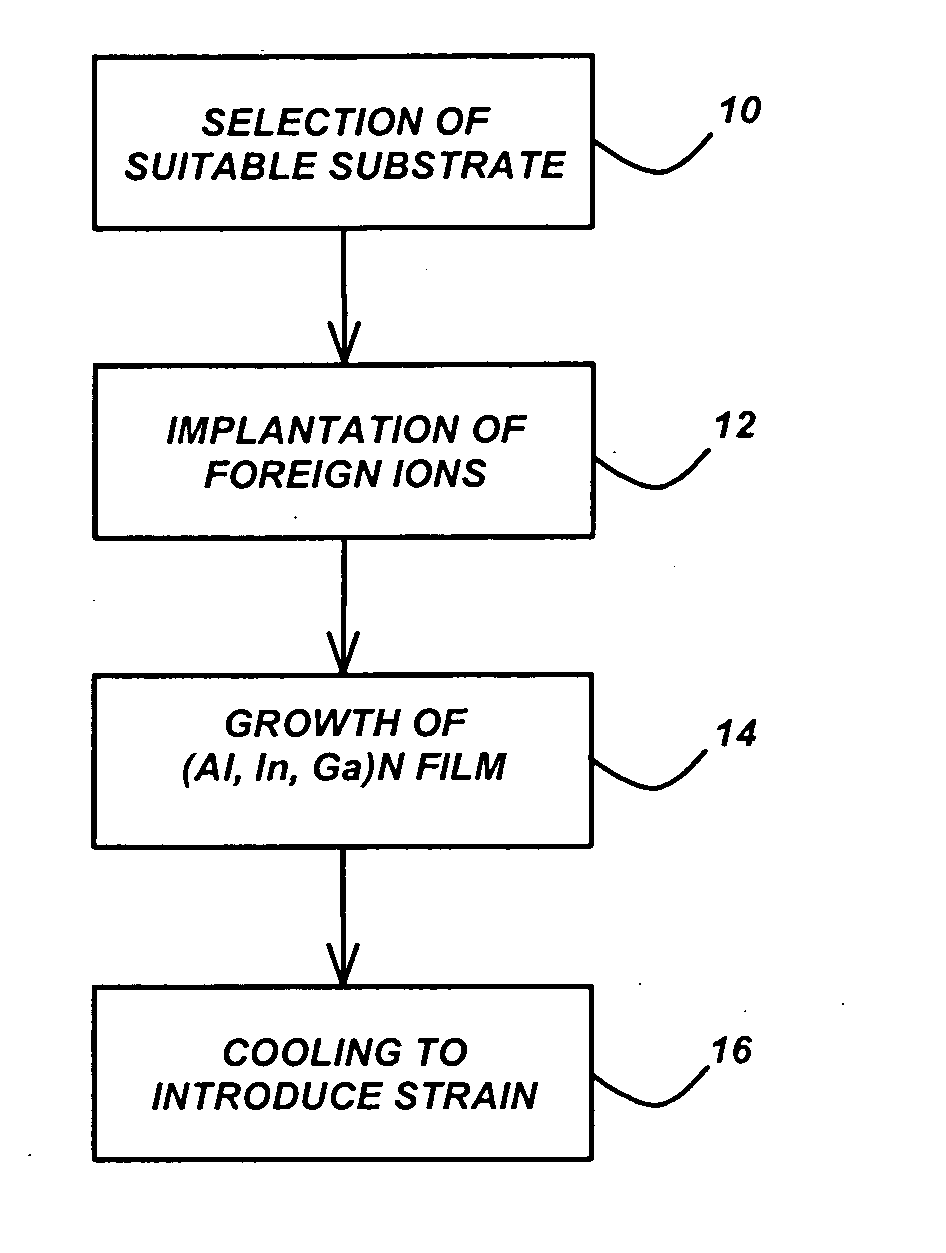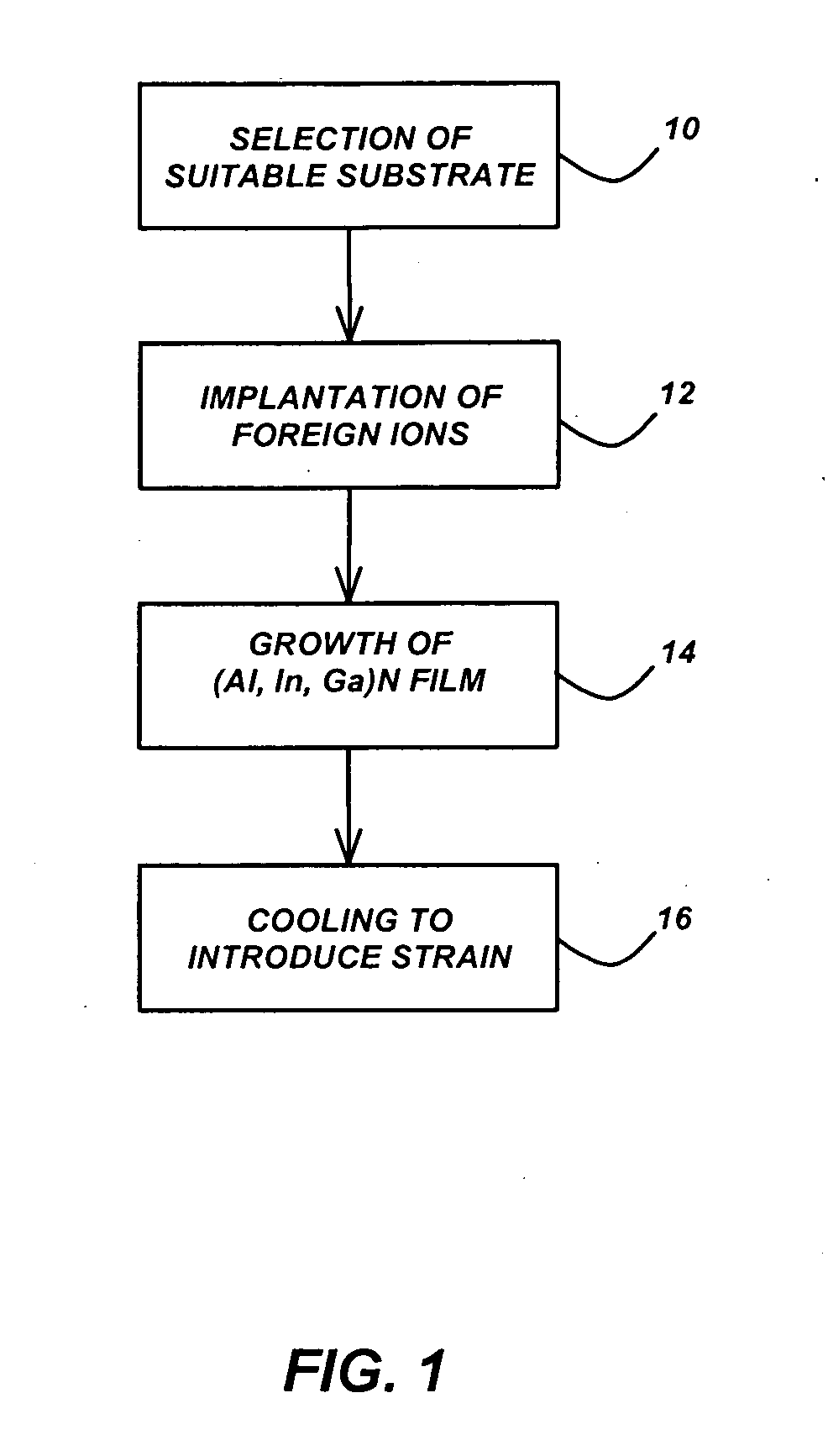Wafer separation technique for the fabrication of free-standing (Al,In,Ga)N wafers
a separation technique and free-standing technology, applied in the direction of polycrystalline material growth, crystal growth process, after-treatment details, etc., can solve the problems of under-use of free-standing gan substrates, cracking of nitride films and/or substrates, etc., to reduce the deleterious effects of stress, eliminate undesirable cracking of films and substrates, and encourage cleavage of composite systems
- Summary
- Abstract
- Description
- Claims
- Application Information
AI Technical Summary
Benefits of technology
Problems solved by technology
Method used
Image
Examples
example 1
[0038] An m-plane 6H-SiC substrate is implanted with a dose of He+ ions with a peak concentration of 5×1016 cm−2 at a depth of 900 nm from the surface. The substrate is then loaded into a HVPE reactor, in which a 300 μm thick m-plane Al0.5Ga0.5N film is grown at 1200° C. During the course of the growth, the He+ ions migrate laterally and coalesce to form microvoids approximately on a plane parallel to the SiC m-plane. Upon cooling, stress due to thermal expansion mismatch causes the m-plane SiC substrate to spontaneously cleave at the microvoided layer. The remaining SiC substrate is re-polished and used for a subsequent growth. The m-plane AlGaN film now exists as a free-standing wafer with an approximately 900 nm thick SiC membrane attached to its back side. This SiC membrane is allowed to remain in place as it will not affect subsequent growth on the AlGaN growth surface.
example 2
[0039] A c-plane Al2O3 substrate is implanted with a dose of H+ ions with a peak concentration of 3×1016 cm−2 at a depth of 1000 nm from the surface. The substrate is then loaded into a HVPE reactor, in which a 300 μm thick Si-doped c-plane GaN film is grown at 1050° C. During the course of the growth, the H+ ions migrate laterally and coalesce to form microvoids approximately on a plane parallel to the Al2O3 c-plane. Upon cooling, thermal expansion mismatch related strain causes the c-plane Al2O3 substrate to spontaneously cleave at the microvoided layer. The c-plane GaN film now exists as a free-standing wafer with an approximately 1000 nm thick Al2O3 membrane attached to its back side. The Al2O3 membrane is removed by brief chemi-mechanical polishing to facilitate backside electrical contacting of subsequently grown devices on the free-standing GaN substrate.
example 3
[0040] An r-plane Al2O3 substrate is implanted with a dose of Ar+ ions with a peak concentration of 1×1017 cm−2 at a depth of 500 nm from the surface. The substrate is then loaded into a HVPE reactor, in which a 200 μm thick Si-doped a-plane GaN film is grown at 1050° C. Following the growth of this thick GaN film, a 5 μm-thick pn-junction diode structure is grown by adding Si and Mg to subsequent layers. During the course of the growth, the Ar+ ions migrate laterally and coalesce to form microvoids approximately on a plane parallel to the Al2O3 r-plane. Upon cooling, thermal expansion mismatch related strain causes the r-plane Al2O3 substrate to spontaneously cleave at the microvoided layer. The a-plane GaN film and diode now exist as a free-standing wafer with an approximately 500 nm thick Al2O3 membrane attached to the back side of the nitride film. The Al2O3 removed by brief chemi-mechanical polishing to facilitate backside contacting to the n-type region of the pn-junction diod...
PUM
 Login to View More
Login to View More Abstract
Description
Claims
Application Information
 Login to View More
Login to View More - R&D
- Intellectual Property
- Life Sciences
- Materials
- Tech Scout
- Unparalleled Data Quality
- Higher Quality Content
- 60% Fewer Hallucinations
Browse by: Latest US Patents, China's latest patents, Technical Efficacy Thesaurus, Application Domain, Technology Topic, Popular Technical Reports.
© 2025 PatSnap. All rights reserved.Legal|Privacy policy|Modern Slavery Act Transparency Statement|Sitemap|About US| Contact US: help@patsnap.com


